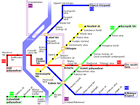Budapest, October 29, 2011 (EFE) .- The Ludwig Museum in Budapest starting today offers an exhibition on the work and theories of the influential Hungarian architect Yona Friedman French, their space cities, and building a "democratic and active "
The show is titled "Architecture without Building", which reflects the fact that the draft Friedman, one of the most influential theorists of modern architecture were not realized.
However, to illustrate the theories of the architect, the Museum Ludwig has included numerous installations in the exhibition.
The thrust of Friedman's theories, considered a utopian architect, are based on the fact that cities and metropolitan areas collapsed or are collapsing, so necessary to leave the building horizontal, vertical and opt for.
In this sense, the most striking installation of the exhibition will be open until January 8, 2012, is an example of what the architect called "space city" ("Ville Spatiale").
Friedman was born in Budapest in 1923, survived the Holocaust and in 1945 he left his hometown and moved to Israel, where he studied architecture. Since 1956 lives in Paris.
According Hajnalka Somogyi, one of the curators of the exhibition, of his experiences during World War II, Friedman concluded that "cities are unable to defend its people" and created his "theory of urban centers."
That theory was developed in the 1950 and reflected in their manifesto "mobile architecture" (1956), which proposes, among other things, the construction of cities that can be restructured by the inhabitants themselves.
It would be a second city, built on stilts over the existing, and offering the possibility that each person design their field, according to their own requirements. These structures could also plan on agricultural land or areas not constructible.
The theory is based on preliminary studies on mathematics, economics and sociology, which reflects the sample installations, models, drawings and videos.
It is "a democratic idea" because the architect is no longer "a god who creates the space for its inhabitants" to provide the participation of residents in creating the final product, Somogyi emphasized in remarks to the press.
This architecture is characterized by the use of volatile and variable structures, interconnected, that the architect recommended that cities like Paris, Shanghai and Venice, as well as a bridge to join Europe, Gibraltar, Africa.
For his part, French Gonzague Lacombe, responsible for sample design, highlighted the important place in the work of Friedman "active man", which transforms its habitat.
As early as 1970, the architect warned that the Western lifestyle was unsustainable and proposed the rationalization of urban life, said Nikolett Eross, another curator of the exhibition.
A multilevel space, which connects a vegetable garden bathrooms and kitchens, is one of Friedman's proposals.
The exhibition offers the opportunity to rethink everything seen in six rooms and visitors, at the end of your walk, you can experiment with items such as corks, plastics and others, to make creations "in the style of Friedman," said Eross .
In the construction of the facility helped 40 volunteers, who worked for three weeks on the project, while the realization of the sample had the support of institutions like the Centre Pompidou and the Museum of Modern Art in Paris, among others.
Marcelo Nagy


